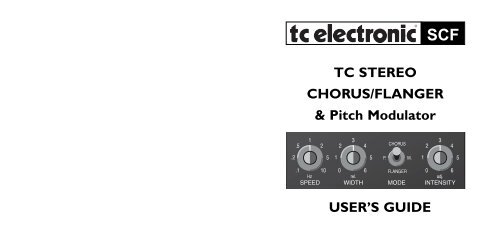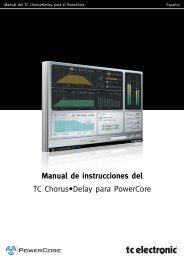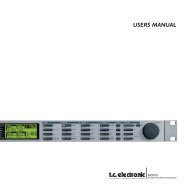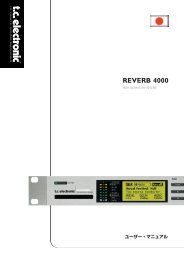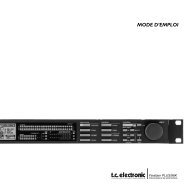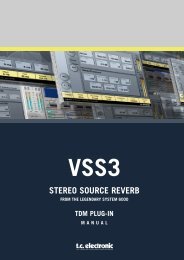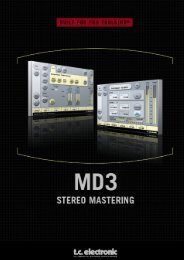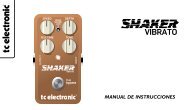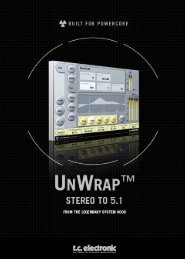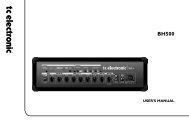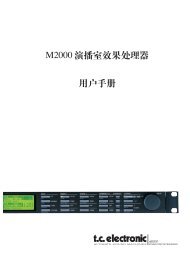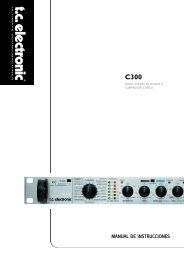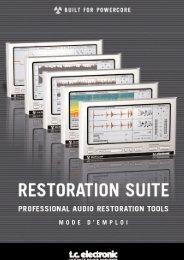SCF Stereo Chorus Flanger Manual English - TC Electronic
SCF Stereo Chorus Flanger Manual English - TC Electronic
SCF Stereo Chorus Flanger Manual English - TC Electronic
Create successful ePaper yourself
Turn your PDF publications into a flip-book with our unique Google optimized e-Paper software.
<strong>SCF</strong><br />
<strong>TC</strong> STEREO<br />
CHORUS/FLANGER<br />
& Pitch Modulator<br />
USER’S GUIDE
CONTENTS<br />
Contents . . . . . . . . . . . . . . . . . . . . . . . . . . . . . . . . . . . 3<br />
Introduction . . . . . . . . . . . . . . . . . . . . . . . . . . . . . . . . 4<br />
<strong>SCF</strong> Sound Quality . . . . . . . . . . . . . . . . . . . . . . . . . . 7<br />
Front Description . . . . . . . . . . . . . . . . . . . . . . . . . . . . 10<br />
Getting Started . . . . . . . . . . . . . . . . . . . . . . . . . . . . . . 13<br />
The Controls . . . . . . . . . . . . . . . . . . . . . . . . . . . . . . . 14<br />
Examples of Settings . . . . . . . . . . . . . . . . . . . . . . . . 18<br />
Technical Specifications . . . . . . . . . . . . . . . . . . . . . . 19<br />
Troubleshooting . . . . . . . . . . . . . . . . . . . . . . . . . . . . 20<br />
Notes . . . . . . . . . . . . . . . . . . . . . . . . . . . . . . . . . . . . . . 23<br />
3
INTRODUCTION<br />
Thank you for purchasing the <strong>TC</strong> <strong>Chorus</strong>/<strong>Flanger</strong>/Pitch<br />
Modulation pedal. <strong>TC</strong> <strong>Electronic</strong> has developed this<br />
product to the highest standards ensuring top sound<br />
quality with no noise or distortion added to your audio<br />
signal.<br />
The "full" spatial effects and the lack of noise has made<br />
the <strong>TC</strong> <strong>SCF</strong> pedal a favorite choice of many professional<br />
musicians both on the road and in the studio.<br />
From the cast aluminum housing to the internal power<br />
supply you will see that professional quality is the<br />
trademark of <strong>TC</strong> <strong>Electronic</strong>s products.<br />
We hope you enjoy your purchase !<br />
INTRODUCTION<br />
Features:<br />
- 3 types of stereo effects<br />
The 3 kinds of effects are all stereo effects, but can be used<br />
in mono as well. The effects are suitable for all electric or<br />
electrified instruments and will in no way compromise the tonal<br />
quality of the instrument.<br />
<strong>Chorus</strong><br />
A chorus is basically a pitch generator which mixes multiple<br />
delay signals. When the multiple delay signals are mixed with<br />
the original signal a soft and wide sounding modulation effect<br />
is created.<br />
FLANGER<br />
A flanger is based on the same principle as a chorus, although<br />
here the signal can be regenerated (like adding feedback on a<br />
delay) creating a more distinctive sounding effect.<br />
4<br />
5
INTRODUCTION<br />
<strong>SCF</strong> SOUND QUALITY<br />
Pitch Modulation:<br />
A combination of chorus and pitch - vibrato which creates a<br />
"light" chorus sound.<br />
Real <strong>Stereo</strong><br />
When using stereo the effect signals and the clean signal<br />
appear simultaneously in both sides. The effect signals are<br />
alternating phase reversed in left and right sides, creating a<br />
unique spatial dimension.<br />
Excellent dynamic range<br />
The 100dB signal to noise ratio means that there is very little<br />
background noise generated by the electronics. This high<br />
signal to noise ratio is very unusual for pedal effects, and<br />
makes this device appropriate for any kind of recording.<br />
Preamp + Line Driver<br />
The <strong>TC</strong> <strong>SCF</strong> can be used with almost any instrument/amplification.<br />
Its built-in preamplifier can handle even the weakest<br />
signals e.g. from some keyboards, mixers and transducer<br />
pickup. High signal output allows long cable runs with full signal.<br />
Frequency response 20-20.000Hz<br />
The wide frequency response is one of the reasons why the<br />
<strong>SCF</strong> pedal sound much better than any other effect pedals of<br />
this type.<br />
Linear frequency response<br />
The linear frequence response of the <strong>TC</strong> <strong>Stereo</strong> <strong>Chorus</strong>/<strong>Flanger</strong><br />
ensures that the sound stays transparent and clear, and that<br />
there will be full effect from the deepest bass note to the<br />
highest harmonics. Rather than cutting off the precious<br />
harmonics of your signal, the harmonics are processed when<br />
the pedal is activated, and allowed to pass completely<br />
unaffected when it is bypassed<br />
DYNAMIC RANGE: 100dB<br />
A dynamic range of 100dB means that the <strong>SCF</strong> is extremely<br />
silent as well as being capable of handling the dynamics of<br />
your signal. - No hiss but all the "punch" you need. With no<br />
noise added, your music will keep its transparency and<br />
brightness so soft passages are clear and rich in harmonics.<br />
6<br />
7
<strong>SCF</strong> SOUND QUALITY<br />
8 9 11 7<br />
PROFESSIONAL SIGNAL LEVELS<br />
One of the key elements to obtaining professional sound<br />
quality is proper impedance at the in and output(s). If an effect<br />
pedal should be able to pick up the full bandwidth from your<br />
instrument, it is very important that it does not "load" your<br />
instrument, i.e. it must have a high input impedance.<br />
To prevent loss through cables, effect loops or loading by the<br />
amp input, the outputs must have drive capability, i.e. the out<br />
impedance has to be very low. Due to the high input and the<br />
low output impedance, <strong>TC</strong> effects do not "steal" any detail of<br />
your signal, neither with the effect on, nor when bypassed!<br />
4<br />
1<br />
6<br />
12<br />
3<br />
2<br />
5<br />
SUPERIOR CIRCUITRY<br />
The <strong>SCF</strong> circuit uses the latest technology of circuitry to give<br />
uncompromised sound and dependable service. The chorus<br />
circuit has been refined by many years of experience by the<br />
<strong>TC</strong> engineers to make the <strong>TC</strong> <strong>Chorus</strong>/<strong>Flanger</strong> sound "state of<br />
the art" ! The components used were chosen for professional<br />
applications so you can expect years of service free durable<br />
performance from your <strong>SCF</strong> pedal.<br />
+<br />
10<br />
8<br />
9
FRONT DESCRIPTION<br />
FRONT DESCRIPTION<br />
1 SPEED Controls the Rate of sweep in a range<br />
from 1 sweep every 10 seconds to 10<br />
sweeps each second (0,1-10 Hz).<br />
2 INTENSITY The INTENSITY potentiometer has 3<br />
functions - one for each mode:<br />
- In the CHORUS mode it blends<br />
between chorus and clean signal.<br />
- In FLANGER mode it controls the<br />
strength of the Comb filter phasing of<br />
the signal (like feedback on a delay).<br />
- In PI<strong>TC</strong>H MODULATION mode it is<br />
blend control, mixing chorus and<br />
vibrato.<br />
3 MODE SELECTOR Switches between the 3 modes of<br />
operation: CHORUS, PI<strong>TC</strong>H<br />
MODULATION (P.M.) and FLANGER.<br />
4 WIDTH Determines how wide a modulation<br />
(sweep) is produced. Ranges are<br />
from "0" (no modulation) to "6"(max) on a<br />
relative scale.<br />
5 INPUT GAIN Controls the gain of the built-in<br />
preamplifier. Ranges from 0dB<br />
(no amplification) to +15dB (= 5 times<br />
amplification).<br />
6 OVERLOAD Indicates when the <strong>TC</strong> <strong>SCF</strong> is close to<br />
being overloaded. Adjust for<br />
occasional peak indication.<br />
7 INPUT JACK High impedance input. Connect your<br />
instrument here.<br />
8 OUTPUT (MONO) Outputs a monophonic effect signal or, if<br />
both outputs are used, the left channel of<br />
the stereo signal.<br />
10<br />
11
FRONT DESCRIPTION<br />
GETTING STARTED<br />
9 OUTPUT Outputs the right channel<br />
(STEREO) of the stereo effects signal.<br />
10 BYPASS Switches the audio signal into or<br />
around the effects circuitry.<br />
11 EX. BYPASS By connecting a simple momentary<br />
switch here, the bypass function can<br />
be remote controlled.<br />
12 LED INDICATOR The LED at the top of the unit<br />
indicates the sweep rate (as set by<br />
SPEED) with effect on.<br />
In BYPASS mode the LED "glows" at a<br />
low levels indicating "power on".<br />
Connect the input source (instrument, pick-up or high output<br />
microphone) by a mono jack cord to the Input jack.<br />
The amplification used (amp(s), mixer) should be<br />
connected by a mono jack cord(s) to: Output jack if you are<br />
using one amp or a mono mixer. Both Output jacks - if you are<br />
using two amps or a stereo mixer.<br />
The <strong>TC</strong> <strong>SCF</strong> has a built-in power supply, which<br />
should be connected to an AC "wall outlet".<br />
12<br />
13
THE CONTROLS<br />
THE CONTROLS<br />
There are four sound controls on the <strong>SCF</strong>:<br />
INPUT GAIN, SPEED, WIDTH and INTENSITY<br />
Setting Input Gain:<br />
Using the <strong>TC</strong> <strong>SCF</strong> with an instrument…<br />
When used with a guitar, bass or keyboard with normal output<br />
volume and an amplifier with normal input volume the<br />
INPUT GAIN should be turned fully counter clockwise.<br />
(The signal will then have an unchanged level).<br />
Or…using the <strong>TC</strong> <strong>SCF</strong> with a mixing console.<br />
The AUX/EXT. EFFECTS SEND on the mixing console<br />
should connect to the <strong>SCF</strong> input and drive with a 0dB signal<br />
level. The INPUT GAIN on the <strong>TC</strong> <strong>SCF</strong> should be adjusted so<br />
the LED lights on the peaks of the input signal only. The <strong>SCF</strong><br />
outputs should be connected to "LINE" input on a mix module<br />
or the effects return module.<br />
Note:<br />
If both outputs are used for stereo, you must use a stereo<br />
return on the mixing console. Do not mix the stereo outputs of<br />
the <strong>TC</strong> <strong>SCF</strong> together! If you do, you will get no effect, as the<br />
effects part of the signal is out of phase on the LEFT/RIGHT<br />
OUTPUT.<br />
SETTING SPEED AND WIDTH<br />
The SPEED and the WIDTH should be regarded as a<br />
set of controls rather than two individual. They both<br />
influence the apparent degree of effect. A good<br />
starting point when creating more "pleasant" sounds<br />
in any of the 3 effect modes is to keep the controls<br />
"generally opposite". Here is an example:<br />
SPEED at ".2", WIDTH at "5" or<br />
SPEED at "5", WIDTH at "1".<br />
14<br />
15
THE CONTROLS<br />
THE CONTROLS<br />
If you want "out of pitch" sounds for special effects, both<br />
SPEED and WIDTH can be turned into the last third of their<br />
range.<br />
Adjusting INTENSITY<br />
This has 3 different functions depending on the mode<br />
setting…<br />
In the CHORUS mode INTENSITY is a control<br />
for the "notching" depth of the chorus effect. Turning the control<br />
clock-wise increases the "notching" which is well suited for non<br />
distorted single and rhythm guitars as well as most keyboards.<br />
With chorus effects applied to song and generally when the<br />
sound is more of a bass character, lower settings should be<br />
used. When using the unit through returns on a mixing console<br />
keep the INTENSITY control at maximum.<br />
In PI<strong>TC</strong>H MODILATION mode, the INTENSITY control mixes<br />
an increasing amount of pitchshift (vibration, following the<br />
speed rate) over the chorus signal. If the control is turned fully<br />
clockwise the chorus part of the signal is at minimum. The<br />
effect is most pronounced at high speed settings, and<br />
applicable to give e.g. a keyboard sound a "leslie-like"<br />
character.<br />
In FLANGER mode, INTENSITY controls the amount of signal<br />
which is regenerated. More regeneration creates a "deeper"<br />
more metallic sound.<br />
16<br />
17
EXAMPLES OF SETTINGS<br />
TECHNICAL SPECIFICATIONS<br />
NAME SPEED INTENSITY MODE WIDTH<br />
CHORUS I 1 4 CHORUS 3<br />
CHORUS II 2 5/6 CHORUS 5<br />
CHORUS III 5 2 CHORUS 5<br />
FLANGER I 2 3 FLANGER 5<br />
FLANGER II 2 2 FLANGER 2<br />
METALLIC<br />
FLANGER 4 4 FLANGER 1<br />
CLASSIC<br />
Dynamic Range . . . . . . . . . . . . . . . . . . . . . . . . . . . . . . . .100dB<br />
Frequency response . . . . . . . . . . . . . . . . . . . . . . . . . .20-20kHz<br />
Input impedance . . . . . . . . . . . . . . . . . . . . . . . . . . . . . .1 Mohm<br />
Output impedance . . . . . . . . . . . . . . . . . . . . . . . . . . . .500 ohm<br />
Max Input level . . . . . . . . . . . . . . . . . . . . . . . . . . . . . . . .+9dBm<br />
Input gain range . . . . . . . . . . . . . . . . . . . . . . . . . . . .0 to +15dB<br />
Max Output level . . . . . . . . . . . . . . . . . . . . . . . . . . . . . .+14dBm<br />
Distortion . . . . . . . . . . . . . . . . . . . . . . . . . . . . . . . . . . . . .
TROUBLESHOOTING<br />
TROUBLESHOOTING<br />
In case you encounter any difficulties, please go thru this<br />
troubleshooting before calling the service center<br />
ERROR<br />
No "on" LED<br />
CHECK<br />
- click the bypass footswitch.<br />
- is there sound?<br />
- try another AC outlet.<br />
ERROR<br />
Distortion<br />
CHECK<br />
INPUT GAIN adjusted too<br />
high - 0dB max should be<br />
put in - install an input<br />
attenuator if necessary - try another<br />
signal source - try another cable -<br />
does the OVERLOAD LED light?<br />
No Sound<br />
- AC outlet OK?<br />
- try to get sound through your amp.<br />
without using the <strong>TC</strong> <strong>SCF</strong>.<br />
- are the cables ok? Try others.<br />
- move all switches back and forth.<br />
- try another sound source.<br />
- test in mono (see chorus problem).<br />
<strong>Chorus</strong> Effect<br />
Do not mix the two outputs together<br />
disappears these are in anti-phase.<br />
To make a mono-compatible effect,<br />
1) Use one output only or<br />
2) With a "splitbox" you can connect<br />
the direct signal to the input of the<br />
<strong>SCF</strong> as well as to Left side of the<br />
stereo, the <strong>SCF</strong> <strong>Stereo</strong> Out jack to<br />
the RIGHT side. Now, set the<br />
MODE switch at P.M. and<br />
20<br />
21
TROUBLESHOOTING<br />
NOTES<br />
INTENSITY at or near maximum.<br />
This set-up will produce a chorus<br />
effect, which is almost as "broad"<br />
and is mono-compatible however<br />
the chorus effect will be at one side<br />
only.<br />
3) Use another <strong>TC</strong> product called<br />
the <strong>TC</strong> 1210 Spatial Expander &<br />
<strong>Stereo</strong> <strong>Chorus</strong>/<strong>Flanger</strong>, which has<br />
two linkable chorus units for full<br />
stereo/mono compability as well as<br />
other exciting effects.<br />
Please read and follow these instructions before<br />
connecting this unit.<br />
The lightning flash with an arrowhead symbol within<br />
a equilateral triangle, is intended to alert the user to<br />
the presence of uninsulated “dangerous voltage”<br />
within the product’s enclosure that may be of<br />
sufficient magnitude to constitute a risk of electric<br />
shock to persons.<br />
The exclamation point within an equilateral triangle<br />
is intended to alert the user to the presence of<br />
important operating and maintenance (servicing)<br />
instructions in the literature accompanying the<br />
product.<br />
This symbol indicates that the unit is double<br />
insulated.<br />
22<br />
23
NOTES<br />
NOTES<br />
This equipment has been tested and found to comply with the<br />
limits for a Class B Digital device, pursuant to part 15 of the<br />
FCC rules.<br />
These limits are designed to provide reasonable protection<br />
against harmful interference in a residential installation.<br />
This equipment generates, uses and can radiate radio<br />
frequency energy and, if not installed and used in accordance<br />
with the instructions, may cause harmful interference to radio<br />
communications. However, there is no guarantee that interference<br />
will not occur in a particular installation.<br />
If this equipment does cause harmful interference to radio or<br />
television reception, which can be determined by turning the<br />
equipment off and on, the user is encouraged to try to correct<br />
the interference by one or more of the following measures:<br />
• Reorient or relocate the receiving antenna.<br />
• Increase the separation between the equipment and receiver.<br />
• Connect the equipment into an outlet on a circuit different<br />
from that to which the receiver is connected.<br />
• Consult the dealer or an experienced radio/TV technician for<br />
help.<br />
The user may find the following booklet, prepared by the<br />
Federal Communications Commission, helpful:<br />
"How to identify and Resolve Radio/TV interference Problems."<br />
This booklet is available from the US. Government Printing<br />
Office, Washington, DC 20402, Stock No. 004-000-0034-4.<br />
Caution<br />
You are cautioned that any change or modifications not<br />
expressly approved in this manual could void your authority to<br />
operate this equipment.<br />
Warning!<br />
To reduce the risk of fire or electric shock, do not expose this unit<br />
to rain or moisture.<br />
Service<br />
All service must be performed by qualified personnel. Servicing is<br />
required when:<br />
- the unit has been damaged in any way, such as<br />
power-supply cord or plug is damaged<br />
- the unit has been exposed to rain or moisture,<br />
or liquid has been spilled into the unit<br />
- objects have fallen into the unit<br />
- the unit does not work properly<br />
- the unit has been dropped<br />
24 25
NOTES<br />
NOTES<br />
Do not attempt servicing of this unit yourself. Always refer to<br />
qualified personal.<br />
Do not use this unit near water; for example, near a bath tub,<br />
washbowl, kitchen sink, laundry tub, in wet basement or near a<br />
swimming pool ect.<br />
This unit should only be connected to correct power supply outlet,<br />
please refer to the technical specifications.<br />
For the customers in Canada:<br />
This Class B Digital apparatus meets all requirements of the<br />
Canadian Interference-Causing Equipment Regulations.<br />
Cet appareil numérique de la classe B respecte toutes les exigences<br />
du Réglement sur le matériel brouilleur du Canada.<br />
Certificate Of Conformity<br />
<strong>TC</strong> <strong>Electronic</strong> A/S, Sindalsvej 34, 8240 Risskov, Denmark, hereby declares on<br />
own responsibility that the <strong>TC</strong> <strong>SCF</strong> Pedal<br />
covered by this certificate and marked with CE-label conforms with following<br />
standards:<br />
EN 60065<br />
Safety requirements for mains<br />
operated <strong>Electronic</strong> and related<br />
apparatus for household and similar<br />
general use.<br />
EN 55103-1 Product family standard for audio,<br />
video, audio-visual and entertainment<br />
lighting control apparatus for<br />
professional use.<br />
Part 1: Emission.<br />
EN 55103-2 Product family standard for audio,<br />
video, audio-visual and entertainment<br />
lighting control apparatus for<br />
professional use.<br />
Part 2: Immunity.<br />
With reference to regulations in following directives:<br />
73/23/EEC, 89/336/EEC<br />
Issued in Risskov, February 99<br />
Anders Fauerskov<br />
Managing Director<br />
26<br />
27


